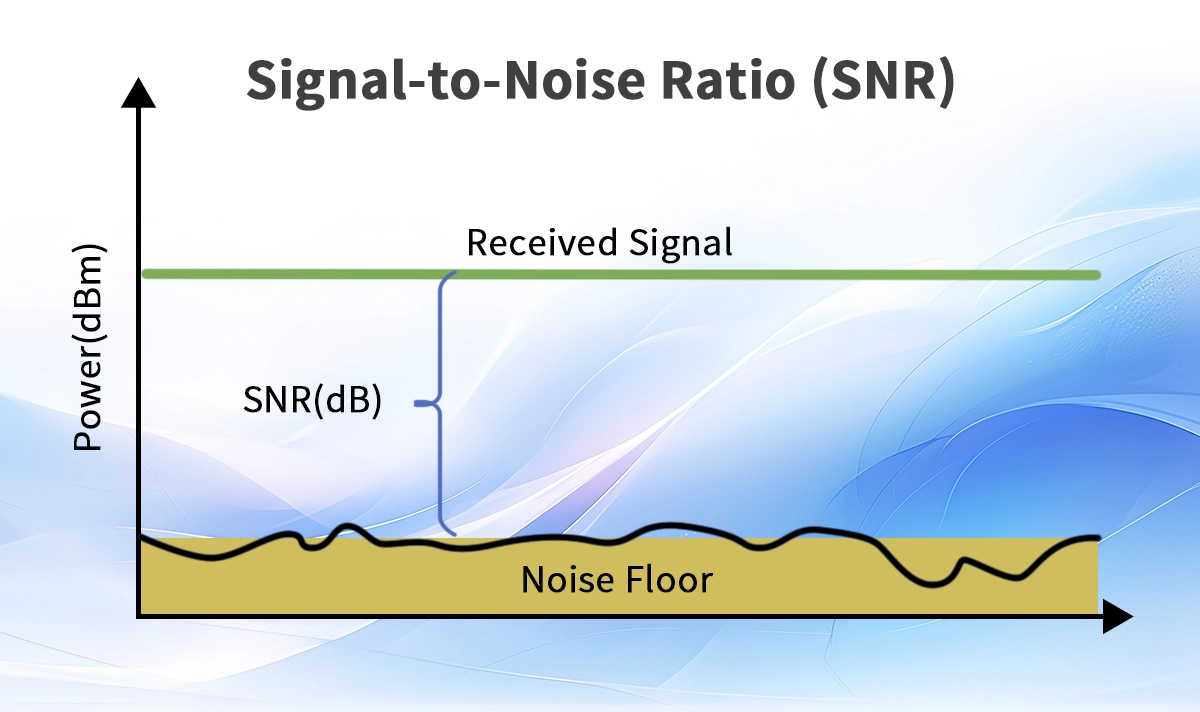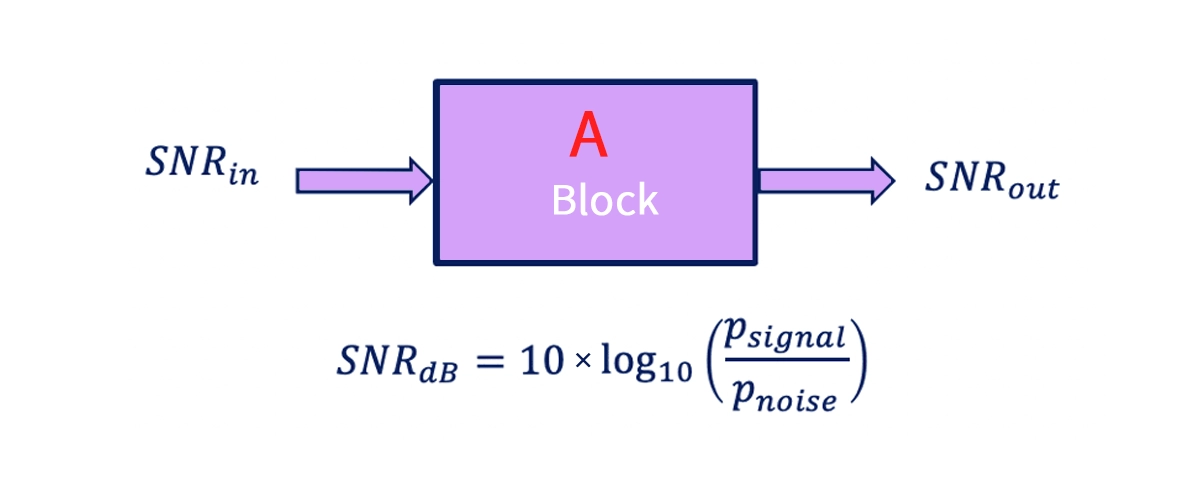
Overview: Signal-to-Noise Ratio (SNR) is a fundamental metric quantifying the strength of a desired signal relative to background noise. Expressed in decibels (dB), a higher SNR indicates a cleaner, more intelligible signal, while a lower SNR means noise drowns out the information. This article dives deep into what SNR is, how it's calculated, why it's crucial across countless technologies (especially in telecommunications and networking), and practical ways to improve it for optimal performance. Understanding SNR is essential for engineers, network professionals, audiophiles, and anyone working with electronic signals.
➣ What is Signal-to-Noise Ratio (SNR)?
In the realm of electronics, telecommunications, audio engineering, and countless other fields, the clarity and integrity of information transmission hinge on one critical factor: the strength of the desired signal compared to the unwanted interference, or noise. The Signal-to-Noise Ratio (SNR) is the fundamental metric that quantifies this relationship. Simply put, SNR measures how much louder or stronger the actual information you want (the signal) is compared to the random, disruptive background fluctuations (the noise) present in the system.
Think of trying to have a conversation in a quiet library versus a noisy factory floor. In the library (high SNR), the other person's voice (signal) is easily heard over the minimal background sounds (noise). In the factory (low SNR), their voice is drowned out by the machinery (noise), making communication difficult or impossible. SNR provides a precise, mathematical way to express this concept for electronic signals.
➣ Why is SNR So Important?
SNR isn't just an abstract number; it directly impacts performance and quality:
Data Integrity & Reduced Errors: In digital communications (like networking, Wi-Fi, cellular), a high SNR means bits (0s and 1s) are transmitted clearly. A low SNR increases the chance that a receiver mistakes a "0" for a "1" or vice versa, leading to Bit Errors. This is directly linked to the Bit Error Rate (BER) – a higher SNR generally means a lower BER, ensuring reliable data transfer.
Signal Clarity & Fidelity: In audio applications, a high SNR delivers clean, crisp sound with minimal hiss or hum. In video, it results in a sharper image with less grain or snow. In scientific instrumentation, it allows for the detection of faint phenomena.
Increased Capacity & Range: Communication systems often operate closer to their theoretical maximum data rates (governed by concepts like the Shannon-Hartley theorem) when SNR is high. Higher SNR can also extend the effective range of a transmission.
System Robustness: Systems designed with sufficient SNR margin are more resilient to temporary noise increases or signal fading.
➣ How is SNR Calculated and Expressed?
SNR is most commonly expressed in decibels (dB), a logarithmic unit. This logarithmic scale is used because signal and noise power can vary over enormous ranges, and dB compresses this range while also aligning with how humans perceive changes in intensity (like sound loudness).

There are two primary formulas for SNR:
Power Ratio (Most Common):
SNR (dB) = 10 * ㏒₁₀(Psignal / Pnoise)
Psignal is the average power of the signal.
Pnoise is the average power of the noise.
㏒₁₀ is the base-10 logarithm.
Amplitude Ratio (Used when measuring voltage, common in audio):
SNR (dB) = 20 * ㏒₁₀(Asignal / Anoise)
Asignal is the root-mean-square (RMS) amplitude of the signal.
Anoise is the RMS amplitude of the noise.
[Note: This uses 20 because power is proportionnal to voltage squared, and ㏒₁₀(X²) = 2 * ㏒₁₀(X)]
Interpreting SNR Values (dB)
SNR values are always relative. Here's a general guide to interpreting them:
SNR Range (dB) | Interpretation | Practical Implication |
|---|---|---|
< 0dB | Very Poor | Noise dominates; signal is unusable. |
0dB to 10dB | Poor | Signal barely detectable; high error rates. |
10dB to 20dB | Marginal / Low Quality | Understandable but with significant noise/errors. |
20dB to 30dB | Acceptable / Moderate Quality | Adequate for voice comms; some noise noticeable. |
30dB to 40dB | Good Quality | Good for most audio/data; noise faint. |
40dB to 60dB | Very Good / High Quality | Excellent clarity; noise negligible for most purposes. |
> 60dB | Excellent / Professional Quality | Near-perfect signal fidelity; noise virtually inaudible. |
➣ Improving SNR: Strategies for Cleaner Signals
Achieving a high SNR is a constant goal in system design and operation. Key strategies include:
Increase Signal Strength: Amplify the source signal (within system limits to avoid distortion). Using higher-quality transmitters or sources.
Reduce Noise Sources: Identify and eliminate or shield components generating electrical noise. Use high-quality, shielded cables. Ensure proper grounding. Separate signal cables from power cables. Operate in electromagnetically quiet environments where possible.
Filtering: Employ electronic filters (band-pass, low-pass, high-pass) to block noise frequencies outside the desired signal band. This is crucial in optical module design.
Signal Processing: Utilize techniques like averaging (reduces random noise), correlation, or specialized modulation schemes that are more noise-resistant.
Component Selection: Using high-sensitivity receivers and low-noise amplifiers (LNAs) at the front-end significantly improves the received SNR. The quality of optical transceivers directly impacts the SNR in fiber optic communications.
Optimize Transmission Medium: Ensure fiber optic cables are clean, undamaged, and properly connected to minimize loss and back-reflection (which induce noise). For RF, use appropriate antennas and line-of-sight.
➣ SNR in Optical Communication and Networking
SNR is paramount in high-speed data transmission over optical fiber, the backbone of modern networks (data centers, telecom, internet infrastructure). Here's why:
High Data Rates: Technologies like 100G, 400G, and beyond push components to their limits. Maintaining a high optical module SNR is critical to achieve low BER at these speeds.
Long Distances: As signals travel kilometers through fiber, they attenuate (weaken), while noise accumulates. Sufficient initial SNR provides the necessary margin.
Non-Linear Effects: At high optical powers, complex non-linear effects within the fiber itself can generate significant noise, degrading SNR. Careful power management is essential.
Component Imperfections: Lasers, photodiodes, amplifiers, and connectors within optical transceivers all introduce some level of noise. High-quality components minimize this intrinsic noise.
Dispersion: Chromatic and polarization mode dispersion can smear pulses, effectively reducing the signal power relative to noise at the decision point in the receiver.
➣ LINK-PP: Engineering Optical Modules for Superior SNR
At LINK-PP, we understand that exceptional transceiver performance SNR is non-negotiable for reliable, high-bandwidth networks. Our optical modules are meticulously engineered from the ground up to maximize signal integrity and minimize noise generation:
Low-Noise Lasers & Drivers: Precision components ensure a clean, stable optical output signal.
High-Sensitivity APD/PIN Receivers: Optimized to detect faint optical signals with minimal added noise.
Advanced DSP (Digital Signal Processing): Used in coherent modules (e.g., QSFP-DD, CFP2) for sophisticated noise filtering, dispersion compensation, and signal equalization, dramatically improving effective SNR.
Rigorous Signal Integrity Design: Careful PCB layout, shielding, and power regulation minimize electrical noise within the module.
Comprehensive Testing: Every LINK-PP module undergoes stringent SNR and BER testing under various conditions to guarantee performance.
LINK-PP Modules Engineered for Optimal SNR
SFP-1G-SX / SFP-1G-LX: Ideal for Gigabit Ethernet, offering robust SNR in fiber optic communications for enterprise access layers.
SFP‑10G‑SR / SFP‑10G‑LR: Delivers reliable 10G performance with excellent signal clarity in data centers and metro networks. Features optimized SFP+ signal quality.
QSFP28-100G-SR4 / QSFP28-100G-LR4: Our high-performance 100G solution, crucial for data center spines and high-speed interconnects. Incorporates design choices specifically for QSFP28 SNR optimization to handle demanding 100Gbps traffic.
QSFP-DD-400G-FR4 / QSFP-DD-400G-LR4: Leveraging cutting-edge coherent DSP technology, these modules achieve the high SNR necessary for error-free 400G transmission over significant distances, demonstrating the pinnacle of LINK-PP optical module engineering for SNR management.
➣ Conclusion: SNR – The Unseen Arbiter of Quality
Signal-to-Noise Ratio (SNR) is far more than just a technical specification; it's the fundamental determinant of whether information gets through clearly or gets lost in the static. From the music we hear to the data that powers the internet, a high SNR is synonymous with quality, reliability, and performance. Understanding SNR principles – how it's measured, why it degrades, and how to improve it – is essential for anyone designing, deploying, or maintaining systems that handle electronic or optical signals.
In the demanding world of optical networking, choosing transceivers engineered for superior SNR, like those from LINK-PP, is critical for building robust, high-capacity, and future-proof networks. By prioritizing SNR optimization, you ensure your data flows cleanly, efficiently, and reliably.
Optimize Your Network's Performance with LINK-PP
Struggling with signal integrity issues, high error rates, or planning an upgrade to higher speeds? SNR is likely a critical factor. LINK-PP's range of high-performance optical modules is specifically designed to deliver exceptional signal-to-noise ratio, ensuring maximum data integrity and network reliability.
➣ FAQ
What does a negative SNR mean?
A negative SNR means noise is stronger than the signal. You may hear more static than music or see more grain than image. Try to reduce noise or boost the signal for better quality.
How can you improve SNR at home?
You can move closer to your Wi-Fi router, use shielded cables, or pick quiet rooms for recording. Clean your devices and check for interference from other electronics. These steps help you get a clearer signal.
Why do digital systems have higher SNR than analog?
Digital systems use advanced coding and error correction. They block out most noise and keep the signal strong. You get clearer sound and images with digital devices.
Does higher SNR always mean better quality?
Usually, higher SNR gives you better quality. Sometimes, other factors like distortion or poor equipment can still affect the result. Always check both SNR and device quality for the best experience.
Can SNR affect internet speed?
Yes! Low SNR can slow down your internet or cause dropped connections. High SNR helps you get faster, more stable downloads and smoother video calls.
➣ See Also
Laser Types in Optical Transceivers: A Comprehensive Guide


